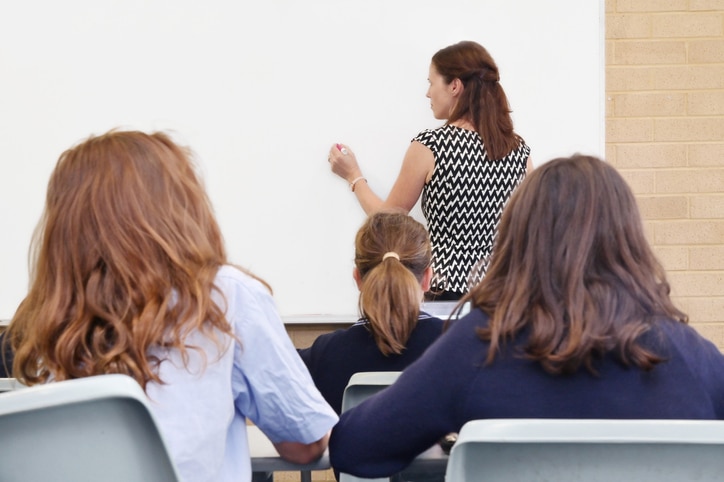For months now, shadow education minister Jeremy Hanson MLA has called on the ACT Government to address Canberra’s teacher shortage.
“We’ve met with denials when we’ve raised issues about staff shortages, or the government’s really downplayed it,” Mr Hanson told Canberra Daily last year, feeling vindicated by an Australian Education Union ACT survey which revealed that teachers were “under-staffed, under-resourced, and under-appreciated”.
In response, the ACT Government set up a taskforce, but Mr Hanson was concerned it would be only window-dressing. The government had already rejected the Liberals’ call for an independent investigation into the education system.
So Mr Hanson was surprised and delighted, he said in the Legislative Assembly yesterday, that his motion to address the teacher shortage in the ACT was passed with unanimous support from the other parties and only minor modifications.
“I am pleased, finally, that the government has accepted my call,” Mr Hanson said. “I’m optimistic that this important first step will make a genuine difference to support our great teachers across ACT public schools.”
Read more:
- National teacher shortage puts pressure on ACT teaching staff (September 2021)
- Liberals want government taskforce to respond to ACT’s education crisis (September 2021)
- New taskforce to address under-staffed, under-resourced teachers (August 2021)
- Government rejects Liberals’ education inquiry (June 2021)
- Liberals’ report criticises education strategy and school infrastructure (June 2021)
- Liberals give ACT Government a failing school report (June 2021)
Liberals, Labor, and Greens all acknowledged there was a problem, and the government’s response to his motion would help, rather than whitewash the issue, Mr Hanson said.
His bill called for the ACT Government to provide a clear plan, with costings and delivery dates, to recruit and retain teachers to address the teacher shortage in the ACT, by the first sitting of 2023.
The government would also provide a report including: how many full-time teachers the ACT needed now and up to 2028; how many teachers were in the system currently; how many had left; and how many had been recruited this year.
In his speech, Mr Hanson blamed the ACT Government for the teacher shortage, particularly education minister Yvette Berry MLA.
“This planning should already have occurred, and my motion really should not have been necessary,” he said after the debate. “It is a problem that has grown about for years, and the Minister has been asked time and time again to provide this information, and to develop a plan to deal with the problem.”
Although ACT Labor made an election commitment in 2020 of 400 new teachers to address the shortage, Mr Hanson remarked that the ACT Government had cut real expenditure per full-time equivalent student in public schools by 3.3 per cent between 2010–11 and 2019–20.
(According to the Productivity Commission Report on Government Services, state and territory government expenditure had decreased from $21,221 per full-time equivalent student in 2010–11 to $20,517 in 2019–20.)
Incidents of violence, bullying, and assault – notably at Calwell High, closed by WorkSafe ACT after students attacked teachers – were due to the teacher shortage, Mr Hanson argued.
Labor response
Ms Berry agreed to Mr Hanson’s call for a report and plan, but modified his bill to defend her government’s support for public schools.
“The ACT Government funds above and beyond the Gonski schooling resource standard, meaning that ACT public schools are the best funded in the country, with the exception of the Northern Territory,” she said, pointing to the same ROGS.
In 2019–20, the ACT Government spent $20,517 per FTE student: $23 less than the NT’s $20,540, but $2,655 more than the third highest, NSW ($17,862); $4,930 more than the lowest, Victoria ($4,930); and $3,582 more than the Australian average ($16,935).
“ACT Government funding for the public school system has grown year on year,” Ms Berry said. The last budget spent $1.5 billion on education (including an extra $51 million): 20 per cent of total government spending; while ACT public school teachers were the highest paid in the country.
“Having well-funded public schools does not make the ACT immune to the national shortage,” she said. “Nor does it make us immune to the COVID-19 pandemic and the effect of staff absences. These are real challenges facing ACT schools.”
The government was working with unions – the Australian Education Union, the Community and Public Sector Union, and the United Workers Union – to ensure schools operated safely during the pandemic and support staff with the increased workload, Ms Berry stated.
The government had partnered with the AEU to form the Teacher Shortage Taskforce, and had already introduced a centralised relief teacher pool and reduced workload by lessening reporting and introducing two more planning days.
To retain teachers, the University of Canberra’s Affiliated Schools Program gave pre-service teachers professional experience placements in schools, while teachers were mentored.
“This government is determined to listen to public school teachers, leaders, and school staff,” Ms Berry said.
“This work isn’t easy, but I’m proud that we’re working together with the union to do the hard work of addressing the national teacher shortage here in Canberra.”
Greens response
The Greens also supported the bill, their education spokesperson Johnathan Davis MLA said.
“We need practical and almost immediate measures endorsed by the directorate and the union to reduce the workload of our teachers,” he said.
“While we struggle to recruit enough teachers, we cannot afford to be bleeding qualified and committed staff because of unreasonable working conditions.”
Mr Davis said the Teacher Shortage Taskforce was “a great first step”. “However, it is important that the taskforce be provided with detailed and comprehensive data to inform their work.”
He hoped the new federal government would reform education, and address funding inequalities for public schools, including concerns rasied in the AEU’s ‘Every School Every Child’ campaign.
“I thank the Canberra Liberals for this important motion,” Mr Davis said. “While rare, it’s always encouraging when the Assembly can come together and agree.”



